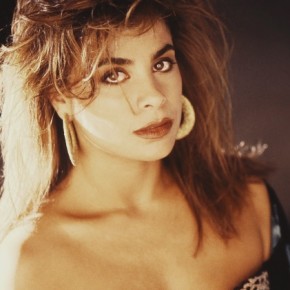 While she’s best known today as a loopy (to put it mildly) reality show judge, Paula Abdul ranked alongside Janet Jackson, Madonna and Whitney Houston as one of the biggest female pop stars of the late Eighties and early Nineties. In addition to her musical success, she was a successful choreographer, working on everything from ZZ Top music videos to “The Tracey Ullman Show.” I won’t ask what the hell Tracey Ullman needed choreography for, but whatever that was, Paula did it!
While she’s best known today as a loopy (to put it mildly) reality show judge, Paula Abdul ranked alongside Janet Jackson, Madonna and Whitney Houston as one of the biggest female pop stars of the late Eighties and early Nineties. In addition to her musical success, she was a successful choreographer, working on everything from ZZ Top music videos to “The Tracey Ullman Show.” I won’t ask what the hell Tracey Ullman needed choreography for, but whatever that was, Paula did it!
Born and raised in California (and allegedly boasting a young Michael Bolton as her babysitter at one point,) Paula first made waves as a Laker girl-choreographing routines for the cheerleading troupe and catching the eye of Jackie Jackson, oldest brother of the legendary Jackson family. According to the original pressing of J. Randy Taraborelli’s biography Michael Jackson: The Magic & The Madness, Jackie and Paula embarked on a torrid affair while conveniently forgetting one thing—Jackie was married. At any rate, Paula’s first choreography job was on The Jacksons’ “Torture” video (AKA the video Michael and Jermaine both sing on but don’t appear on,) and she gained even more fame for her work on Janet Jackson’s “What Have You Done For Me Lately” and “Nasty” clips, which broke the youngest Jackson on MTV and helped turn her into a superstar. Blink and you’ll miss Paula’s cameo as one of Janet’s friends in the “Nasty” video.
While doing choreography work for music videos, TV series and film (she was a busy girl,) Paula began working on a demo to fulfill her dream of becoming a singer, eventually signing with Virgin Records. Originally marketed as a racially ambiguous R&B/dance artist, despite being a Jewish girl from California, she quickly scored a pair of top ten hits on the Black chart (as Billboard called it back then) with “(It’s Just) The Way That You Love Me” and the L.A./Babyface-produced “Knocked Out.” Half a year after Forever Your Girl (her debut album)’s release, Paula finally hit pop pay dirt with “Straight Up.” Thanks to the utilization of a popular slang phrase and a video featuring some snappy choreography as well as a cameo from the red-hot Arsenio Hall (who was reported to be dating Paula at the time,) the song hit the top of the pop charts and became one of 1989’s biggest hits. Forever Your Girl’s title track followed “Straight Up” to the #1 spot, followed by “Cold Hearted” (boasting an extremely suggestive video) and “Opposites Attract,” which featured Paula dancing alongside an animated cat. “Straight Up” and “Opposites Attract” were also top five R&B hits. The album eventually crowned the Billboard 200 as well, certifying Paula as a major multimedia star, although purists of all genres scoffed, saying she was just a pretty face with a thin voice. Shrugging off the criticism was easy to do when Paula also took home a few MTV and American Music Awards for her trouble.
In the wake of the Milli Vanilli lip-synching scandal of 1990, a lawsuit was filed by former Mary Jane Girl Yvette (Corvette) Marine, alleging that her vocals and Paula’s were blended on Forever Your Girl to come up with the final product. Paula and her label, Virgin, emerged from the suit victoriously. With her artistic integrity (believe me, it took a lot to write that with a straight face) in question, Paula joined forces with NYC art-funk-rockers The Family Stand for her second studio album, Spellbound. It reached the top spot of Billboard’s pop album chart, although it wasn’t near as R&B-friendly as her previous work. None of the album’s singles peaked in the Top 10 of Billboard’s R&B charts, although two tracks topped the Pop Hot 100. A successful tour to support the album followed, on which Color Me Badd served as support. More controversy followed in regards to Paula’s fluctuating weight, a situation that reached surreal heights of ridiculousness when her video for “The Promise Of A New Day” found the film stretched lengthwise to make her seem slimmer.
Paula took another break, during which she married Brat Pack actor Emilio Estevez. By the time she returned in 1995, she was a divorcee (not WINNING,) and music fans had largely moved on. The fact that her rival Janet Jackson had become the grand dame of Virgin Records during Paula’s absence probably didn’t help much. Paula disappeared to lick her wounds for a while, resurfacing in 2002 as the host of singing reality show American Idol. The irony of Paula Abdul judging a singing show was not lost on me, but she re-attained superstar status, thanks to her banter with fellow judge Simon Cowell, and gushing, occasionally loopy critiques. How loopy, you ask? So loopy that rumors of an addiction to painkillers persist despite consistent denials from Paula. She left the show in 2009, going on to host her own reality show and she reunited with Cowell briefly in 2011 to judge another singing-based reality show, X-Factor. Aside from a couple of stray singles, however, Paula has yet to fully resume her singing career. Her last full-length album release remains 1995’s Head Over Heels.
